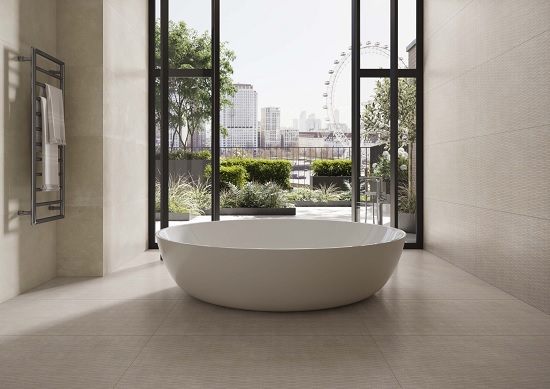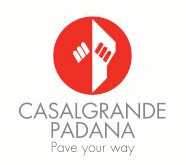Casalgrande Padana presents The City Collection, a new collection of coverings with a modern style.
In collaboration with the SBGA architecture firm in Milan, KPF enthusiastically embraced the idea of studying a collection able to use cutting-edge production techniques to create a modern material expression. The designers sought to achieve the appearance and diversity of natural materials, enhancing them with the desirable technical characteristics of porcelain stoneware.
The City Collection by KPF evolved from the collaboration with Casalgrande Padana, with an ambition to create a new porcelain stoneware tile collection for use in a wide range of interior applications. The intention was to create a new material expression, an authentic version of the modern ceramic manufacturing process, with a material able to boast the strength and technical performance of ceramics, coupled with the aesthetic qualities and diversity of natural stone.
Inspired by the four international cities KPF has a lengthy relationship with, having worked on various buildings and in various neighbourhoods over the years, The City Collection comes in four textures (Hong Kong, London, New York and Shanghai), in a 60×120 cm size, with a thickness of 9 mm and a natural surface.
The City Collection derives from the aspiration to create a series of porcelain stoneware tiles able to embody the subjective experience of each of the places, featuring references to the character, materials, urban shapes and patterns of these fabulous cities. The patterns and textures are the result of a close look into the nature of each city, on various levels, and of a subsequent process of simplification and abstraction designed to create surfaces resembling natural materials.
From a distance, the tiles in the collection are perceived as finely grained surfaces, with subtle variations in colour and texture. When viewed at close range, however, it is possible to discern the geometric patterns the inspiration came from. KPF enthusiastically embraced the opportunity to develop a collection that uses the latest production techniques to create a modern material expression, authentic to the manufacturing process. The designers sought to achieve the aesthetic qualities of natural materials, with the desirable characteristics of man-made ceramics, to develop a range that could be used in place of stone or concrete.
City New York
New York is synonymous with the rigorous city grid that permeates the whole experience of the place. In three dimensions, the grid becomes a continuous experience of vanishing points meeting on the horizon at the end of every street. The repetition of windows, both vertically and horizontally, introduces a continuous texture that permeates the city fabric at every level. At ground level, New York offers an undeniably intense experience. It’s sufficient to rise above street level, or take a step back to perceive the general pace and pattern of the city, supported by the very level that defines the intensity.
It is this experience, coupled with the strong and ever-present diagonality that were the starting point for the New York tile.
The urban experience of New York is defined by single-point perspectives. Repeated architectural features at this scale create a rhythm that intensifies the street perspectives.
This effect of converging parallels and repetitive forms is abstracted into a simple geometrical figure of diagonal banding, articulated by rhythmic verticals to create a pattern that reflects this experience. The resulting pattern is expressed through tone, texture and glaze, capturing light and shade. The effect is evocative of the energy and rhythm of New York and has a cinematic quality.
City London
It is impossible to think about London without reference to the great parks, the Georgian squares and the broad tree-lined avenues that are ever-present in the fabric of this city. The huge plane trees, with their mottled bark and the shimmering green canopies that hover overhead, are at the heart of the true London experience. This natural backdrop is offset by the recognisable London Stock brick, Portland Stone and stucco that permeate the many and varied neighbourhoods across the city.
For the London tile, inspiration was drawn from the organic forms of the natural landscape that weaves through the city. Not only the sinuous, picturesque landscaping of the parks, but also the pattern, grain and texture of tree bark to create a synthesis of the many different scales of the city. There are more than 35,000 acres of public gardens, parks and forests in London. The abundance of green cultivates recurring patterns in the organic formations of trees, leaves and bark textures. The pattern for the London tile was inspired by the natural grain of the bark, superimposed on the organic vertical movement typical of trees.
Repetitive but varied patterns are layered over an abstract texture that references the light palette of London Stock bricks and Portland Stone, which forms the material background to the city.
City Hong Kong
Hong Kong is a city instantly recognizable through the striking verticality that predominates.
A relentless rise towards the sky, emphasized through the repetition of architectural forms. At ground level, the sky is often almost imperceptible, with the irregular geometries of the street grid obscuring the horizon.
The inspiration for the Hong Kong tile came from the subtly shifting pattern of grids and windows across the skyline, which gently undulate as buildings vary in location, geometry, scale and perspective in response to the eccentricities of topography and the historical evolution of the city fabric. The urban experience is defined by the high-rise towers that dominate this island city. The density and verticality almost appear to challenge the architectural notion of ‘human scale’. The combination of repeated lateral floors and the vertical motion is extrapolated into a gridded pattern, with the rhythm being broken with subtle irregularities and variations. The resulting geometric pattern retains some of the intensity of the city, but is softened by overlaying a textured background that references the bedrock and mountains surrounding Hong Kong.
City Shanghai
Shanghai is a city of great contrast: the juxtaposition of historic neighborhoods against the hyper- modern metropolis is intrinsic to the character of the place. The old city fabric, and in particular the Shikumen houses and traditional alleyways, is an immediately recognisable element of the city.
The starting point for the Shanghai tile were the repeating patterns of the roofs that appear to float lightly across the historic neighborhoods. Their sloping profiles create an undulating architectural form of compression and expansion, which seems to breathe with the city itself.
The historical districts of Shanghai offer a glimpse into the city’s past, forming a patchwork of neighborhoods from different periods that host a great variety of roof shapes and meandering alleys. The geometry of the roofscape is abstracted with interlocking rhomboidal shapes to create a limitless pattern, overlaid with a textural rhythm and fluid lines extending through the tessellating forms. Thin horizontal and alternating diagonal lines articulate the pattern, beneath which a soft patina is expressed across the surface, creating a natural variation across the continuous pattern.








